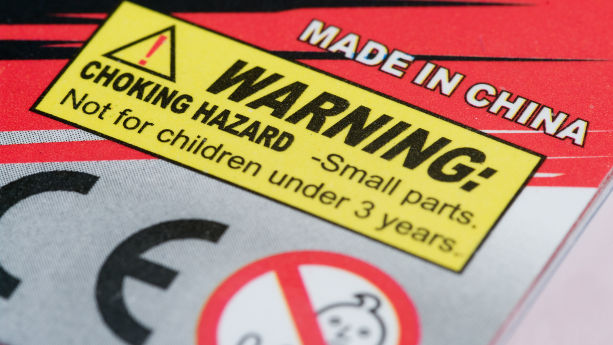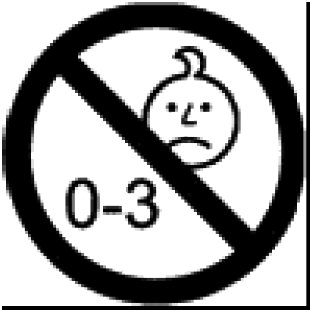Some toys and other children’s products require warning labels before being sold in the EU. These can be warnings that caution the owner of the product from exposing it to children under certain ages or from being used by children in the absence of adult supervision.
These warnings intend lessen certain risks that children face when using the product. For example, products that contain small parts should come with a warning that explains that the product is not suitable for children aged three and below.
In this guide, we provide several regulations that have warning label requirements, examples of warning types, and different types of products that require them. There may exist other warning types that are not mentioned in this guide.
Methodology: The examples provided in this guide are retrieved from information contained in the Toy Safety Directive, the Toy Safety Directive Explanatory Guidance Document, and the General Product Safety Regulation.
Content Overview

FREE CONSULTATION CALL (US, EU & UK)
- Request a free 30-minute call with Ivan Malloci to learn how we can help you with:
- Find product requirements
- Certification and labeling
- Lab testing
Which children’s products require a warning label in the EU?
The Toy Safety Directive sets warning labelling requirements for many types of toys. Here are some examples:
- Toys with small parts
- Activity toys (e.g. swings)
- Functional toys (toys that imitate everyday appliances)
- Chemical toys (e.g. chemistry sets)
- Roller skates
- Scooters
- Toys in food boxes
- Bathing rings
Besides toys, other children’s products may also require warning labels. Specifically, the General Product Safety Regulation contains warning requirements for consumer products, including children’s products.
Here are some examples of products covered under the regulation:
- Children’s clothing containing drawstrings
- Children’s cots and folding cots
- Children’s furniture
- Child care articles
- Cribs
While the GPSR only provides general warning and age-suitability labelling requirements, product standards – either harmonised under the regulation or not, can set product specific warning label requirements.

Age warnings: Toys not intended for use by children under 36 months

The Toy Safety Directive sets age warning requirements for toys that may be dangerous for children under 36 months.
For example, a warning label may appear on board games that contain small parts and pouches containing long drawstrings. For such a product, risks would include choking from the small parts and possible strangulation from the drawstrings.
Note that all warning texts must start with the words “Warning” or “Warnings”, as the case may be.
Product examples
Here are some examples of products that require this type of warning label:
- Products with small parts
- Products with long cords
- Small balls
Warning examples
Here are some examples of warning labels:
- “Not suitable for children under 36 months”
- “Not suitable for children under three years”
Alternatively, the age warning pictogram provided in Annex V of the directive can be used.
In addition to the warning, a brief indication of the hazard associated with the product should be provided. The directive’s Explanatory Guidance Document provides the following examples of hazards that can be mentioned:
- Small parts (choking)
- Small balls – choking
- Long Cord – strangulation (hazard)
Adult supervision warnings
There are products covered by the Toy Safety Directive that require adult supervision when used by children. Such products must come with warnings that communicate that adult supervision is needed.
This is to avoid risks relating to the child’s improper handling of the product. The risks range from physical injuries to chemical burns depending on the product in question.
Below we cover different types of toys that require an adult supervising warning.
Functional toys
Functional toys are products that look like everyday appliances for use by adults and that may be a scale model of such products. These warning labels are needed because such toys may contain sharp edges or small parts, for example.
Such products should also come with instructions, precautions to be taken by the user, and a warning of the possible risks that may arise due to the failure to take precautions.
Product examples
Here are examples of functional toys that require adult supervision warnings:
- Sewing machines
- Coffee machines
Warning example
“To be used under the direct supervision of an adult”
Chemical toys
These are toys that children would be handling or exposed to certain chemical substances and mixtures. Generally, there is a proper way to handle such products and adult supervision is required to ensure that it is used in the right manner.
The risks associated with this product include personal injuries (e.g. chemical burns) and damage to property if the toy causes a fire.
Product examples
Here are examples of chemical toys that require a warning label:
- Chemistry sets
- Plastic embedding sets
- Miniature workshops for ceramics
- Enamelling
- Photography
Warning example
“Not suitable for children under [age to be specified by the manufacturer] years. For use under adult supervision”
Aquatic toys
These are products that are meant to be used in shallow water and that are capable of carrying the child. The risks associated with aquatic toys include drowning from the product’s loss of buoyancy and loss of support to the child. Due to such risks, adult supervision is required.
Product examples
Here are some examples of aquatic toys that require the warning:
- Simple inflatable toys
- Bathing rings
- Fish rings
Warning example
“Only to be used in water in which the child is within its depth and under adult supervision”
Toys in food
These refer to toys that are contained or co-mingled with food products. Such products may present risks of choking for children. For this reason, adult supervision is required.
Product examples
Here are examples of toys in food that require the warning:
- Toys in surprise eggs
- Toys in cereals
- Toys in chips
Warning example
“Toy inside. Adult supervision recommended”
Domestic use warnings
The Toy Safety Directive requires activity toys to come with domestic use warnings. Activity toys are products for domestic use in which the child can engage in physical activities such as climbing, jumping, swinging, and so on.
There are a number of risks associated with the use of this type of product as the child may fall from the activity toy or physical injuries may occur because of the lack of maintenance of the product.
Product examples
Here are some examples of activity toys that require the warning:
- Swings
- Slides
- Carousels
- Climbing frames,
- Trampolines
- Paddling pools
- Non-aquatic inflatable toys
Warning example
“Only for domestic use”
Protective equipment warnings
Certain products covered by the Toy Safety Directive, such as roller skates, should not be used without protective equipment. Such products typically require some skill to be used properly as the products come with different risks such as the risks of falling or colliding with environmental objects (e.g. a wall).
Protective equipment must be used with such products to reduce or eliminate the risk of getting physical injuries (e.g. the damage caused by falling).
Product examples
Here are some examples of products requiring the protective equipment warning:
- Skates
- Roller skates
- Online skates
- Skateboards
- Scooters
- Toy bicycles
Warning example
“Protective equipment should be worn. Not to be used in traffic”
Entanglement warnings
Certain children’s products may come with strings, cords, elastics or straps that carry with them the risk of entanglement. In this case, the Toy Safety Directive sets entanglement warnings.
Product examples
Here are examples of products that require entanglement warnings:
- Toys intended to be strung across a cradle
- Toys intended to be strung on cots
- Toys intended to be strung on perambulators
Warning example
“To prevent possible injury by entanglement, remove this toy when the child starts trying to get up on its hands and knees in a crawling position”
Allergenic warnings
Certain toy products may come with fragrances that may trigger allergies. Annex II of the Toy Safety Directive lists a number of chemical substances in fragrances that require an allergenic warning.
Product examples
Here are examples of products requiring allergenic warnings:
- Olfactory board games
- Cosmetic kits
- Gustative games that contain the fragrances
Warning example
“Contains fragrances that may cause allergies”
Warnings for imitation protective products
Some toys imitate personal protective equipment (PPE) products, such as helmets. For instance, such products can be found in costumes. As these products are not designed to function as PPE products, the Toy Safety Directive requires a warning to communicate to the children and its parents that the product does not provide protection.
Product examples
Here are examples of products that require the warning:
- Fireman’s helmet as part of a dress outfit
- motorcyclist’s helmet as part of a dress outfit
Warning example
“This toy does not provide protection”
Warnings for other children’s products
The General Product Safety Regulation requires products sold to consumers to be safe, this includes children’s products. Under the regulation, products must be assessed for safety. One of the aspects of products that needs to be assessed is the labelling information that is provided with the product, including:
- Age suitability for children
- Any warnings
- Any other indication or information regarding the product
However, the regulation does not go into detail on the requirements for different types of products. Standards harmonised under the regulation and non-harmonised standards may contain warning and instruction requirements.
Should the warning text be printed on the product or the packaging?
Article 11 of the Toy Safety Directive states that you should place the warning text either on the product or packaging in a visible, legible way. If appropriate, the warning statement should also be displayed on the user instructions:
The manufacturer shall mark the warnings in a clearly visible, easily legible and understandable and accurate manner on the toy, on an affixed label or on the packaging and, if appropriate, on the instructions for use which accompany the toy. Small toys which are sold without packaging shall have appropriate warnings affixed to them.
We could not find an Article on the General Product Safety Regulation that explicitly mentions where the warning should be printed. However, Article 19 states the following:
Where economic operators make products available on the market online or through other means of distance sales, the offer of those products shall clearly and visibly indicate at least the following information:
[…]
(d) any warning or safety information to be affixed to the product or to the packaging or included in an accompanying document in accordance with this Regulation or the applicable Union harmonisation legislation in a language which can be easily understood by consumers, as determined by the Member State in which the product is made available on the market.
Compliance Risks
It’s important not to assume that manufacturers outside the EU are aware of EU warning labelling requirements. In fact, even some of the larger toys and children’s products manufacturers expect their customers to provide ready-made warning label files and clear instructions on the placement.
Instead, it’s always best to consult an expert to confirm all applicable and up-to-date warning labelling requirements and send a .ai or .eps file to your supplier before you enter production.
















 Create compliance checklists for your product (US, EU & UK)
Create compliance checklists for your product (US, EU & UK) 20+ product certificate templates
20+ product certificate templates Create label files
Create label files Book product testing
Book product testing